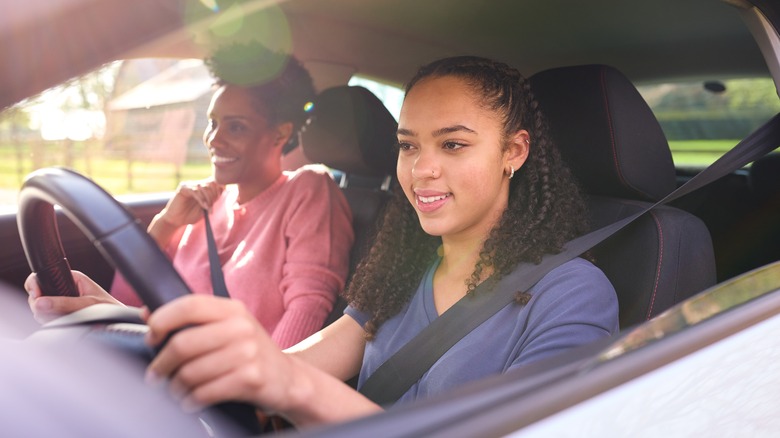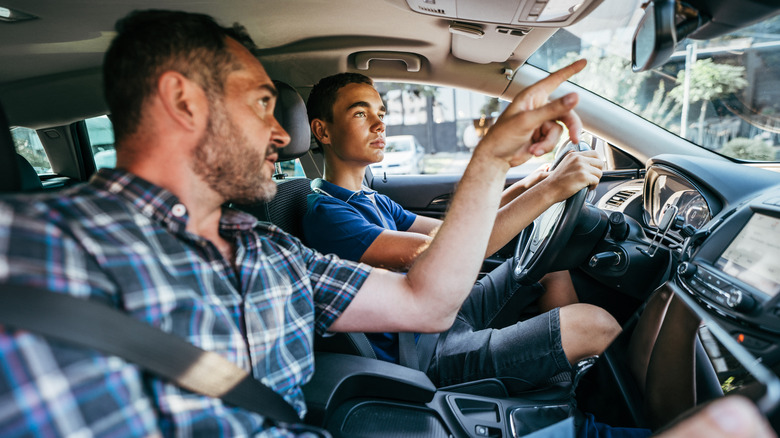Why Is Getting A Driver's License No Longer A Priority For Teens?
Getting a driver's license has long been a rite of passage for teens. They're typically in a hurry to get it as soon as they can, even before they're out of high school if possible. And parents have generally been more than happy to help their teens get their license because it meant less driving for them. Why not switch roles and have your kid chauffeur you around from time to time? It was an opportunity to have more independence. If you were lucky enough to have parents who bought you your first car, it was even more freedom. You could drive to a friend's, get yourself to work or football practice.
According to the Wall Street Journal, 87.3% of 19-year-olds in 1983 had their driver's license. By 2022, that number dropped nearly 20 points down to 68.7%. What changed? Do teens not want as much freedom from their parents as they once did? Do they not want the responsibility that operating a motor vehicle requires? Or are they just that lazy? None of the above, in fact. In case you haven't looked around lately, prices in virtually every industry are up. The average price for a new car is considerably higher than it used to be. Let's not even look at gas prices or the cost of insurance. Then there are the parents to consider. Some parents simply aren't prioritizing it, preferring their children to rely on them to get around over public transportation, while others are too busy to teach their kids to drive.
The cost just isn't worth it anymore
Between 2022 and 2024, new and used car sales have seen a decline of 0.1%. Well that doesn't seem so bad, right? Wrong. Each generation prior to Gen Z at the same stage they are now typically saw a 1% rise year after year in sales. This could be because of rising car prices caused by the COVID-19 pandemic. In 2019, the average price for a new car was $36,824. By 2021, the average jumped to $47,077. Used cars weren't any better, with 2019 prices being around $19,863, jumping to $28,205 in 2021.
Prices in 2024 aren't any better. KBB reports that the average price in August 2024 was $47,870, which is surprisingly lower than the year prior when it reached over $48K. Even budget-friendly used luxury cars are around the cost of something brand-new. It's discouraging to get a license when a car is nearly the cost of a down payment on a house.
Then, there are insurance rates to consider, which are higher than they have ever been. Since December 2021, auto insurance rates have increased 45.8%. According to the WSJ, "Three in 10 people ages 18 to 24 said that they had an insurer-initiated rate increase of more than $300 over the past year." Not only are those rates a challenge for parents with full-time careers to afford, but they're next to impossible for a high school or even college student with a part-time gig.
There are multiple factors at play
It's not any one thing that's turning teens away from getting their driver's license. It's a combination of factors, really. There's a large population of teens whose primary hobby is gaming, and no matter if they play on a PlayStation 5, Xbox, or computer, they can communicate and interact with their friends without being in the same room. Michael Sivak of the University of Michigan Transportation Research Institute in 2012 said, "In our previous research, we found that the percentage of young drivers was inversely related to the proportion of Internet users. Virtual contact, through electronic means, reduces the need for actual contact."
Technology has greatly lowered the priority for teens to get a license. Most higher education schools offer online courses, too, and when they need to leave the house, there are mass transit and rideshare apps like Uber and Lyft. All of these facets of life that once required leaving the house can now be accomplished from our couches. Teens don't seek out summer jobs like they once did, which partly contributes to them not having the money for the different expenses that come with driving.
The numbers show that despite teens driving less than other age groups, minus the elderly, those between 16 and 19 have a crash rate four times higher than drivers 20 years old and older. This has led to some policy changes in most states, raising the minimum age for unrestricted driver's licenses as well as making it more difficult to acquire one even when they're of age.


